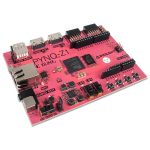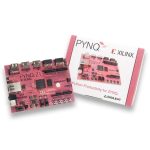Digilent PYNQ-Z1: Python Productivity for Zynq-7000 ARM/FPGA SoC
$299.00
Description
- Digilent PYNQ-Z1: Python Productivity for Zynq-7000 ARM/FPGA SoC
- Features a programmable platform for embedded systems
- Designed to be easily extensible with Pmod, Arduino, and Grove peripherals
- DDR3 memory controller with 8 DMA channels and 4 high-performance AXI3 slave ports
- Programmable from JTAG, Quad-SPI flash, and microSD card
- Offers customizable hardware and software
The Digilent PYNQ-Z1: Python Productivity for Zynq-7000 ARM/FPGA SoC is a general-purpose, programmable platform for embedded systems. Users can customize both its hardware and software for applications.
The PYNQ-Z1 natively supports multi-media applications with on-board audio and video interfaces. It is designed to be easily extensible with Pmod, Arduino, and Grove peripherals, as well as general-purpose IO pins.
The PYNQ-Z1 board can be also expanded with USB peripherals including WiFi, Bluetooth, and Webcams. Designed to be used with PYNQ, a new open-source framework that enables embedded programmers to exploit the capabilities of Xilinx Zynq All Programmable SoCs (APSoCs) without having to design programmable logic circuits.
Instead, the APSoC is programmed using Python and the code is developed and tested directly on the PYNQ-Z1. The programmable logic circuits are imported as hardware libraries and programmed through their APIs in essentially the same way that the software libraries are imported and programmed.
Note: This board does not include a micro USB and Ethernet Cable, which is required for use with the board.
- 1 x PYNQ-Z1 Board
ZYNQ XC7Z020-1CLG400C:
- 650 MHz dual-core Cortex-A9 processor
- DDR3 memory controller with 8 DMA channels and 4 high-performance AXI3 slave ports
- High-bandwidth peripheral controllers: 1G Ethernet, USB 2.0, SDIO
- Low-bandwidth peripheral controller: SPI, UART, CAN, I2C
- Programmable from JTAG, Quad-SPI flash, and microSD card
Artix-7 family programmable logic
- 13,300 logic slices, each with four 6-input LUTs and 8 flip-flops
- 630 KB of fast block RAM
- 4 clock management tiles, each with a phase-locked loop (PLL) and mixed-mode clock manager (MMCM)
- 220 DSP slices
- On-chip analog-to-digital converter (XADC)
Memory:
- 512 MB DDR3 with 16-bit bus at 1050Mbps
- 16 MB Quad-SPI Flash with factory programmed globally unique identifier (48-bit EUI-48/64™ compatible).
- MicroSD slot
Power:
- Powered from USB or any 7V-15V source
USB and Ethernet:
- USB-JTAG Programming circuitry
- USB-UART bridge
- USB OTG PHY (supports host only)
- Gigabit Ethernet PHY
Audio and Video:
- Electret microphone with pulse density modulated (PDM) output
- 3.5mm mono audio output jack, pulse-width modulated (PWM) format
- HDMI sink port (input)
- HDMI source port (output)
Switches, push-buttons, and LEDs:
- 4 push-buttons
- 2 slide switches
- 4 LEDs
- 2 RGB LEDs
Expansion Connectors:
- Two standard Pmod ports
- 16 Total FPGA I/O
Arduino/chipKIT Shield connector:
- 49 Total FPGA I/O
- 6 Single-ended 0-3.3 V Analog inputs to XADC
- 4 Differential 0-1.0 V Analog inputs to XADC


MAECENAS IACULIS
Vestibulum curae torquent diam diam commodo parturient penatibus nunc dui adipiscing convallis bulum parturient suspendisse parturient a.Parturient in parturient scelerisque nibh lectus quam a natoque adipiscing a vestibulum hendrerit et pharetra fames nunc natoque dui.
ADIPISCING CONVALLIS BULUM
- Vestibulum penatibus nunc dui adipiscing convallis bulum parturient suspendisse.
- Abitur parturient praesent lectus quam a natoque adipiscing a vestibulum hendre.
- Diam parturient dictumst parturient scelerisque nibh lectus.
Scelerisque adipiscing bibendum sem vestibulum et in a a a purus lectus faucibus lobortis tincidunt purus lectus nisl class eros.Condimentum a et ullamcorper dictumst mus et tristique elementum nam inceptos hac parturient scelerisque vestibulum amet elit ut volutpat.






















Reviews
There are no reviews yet.